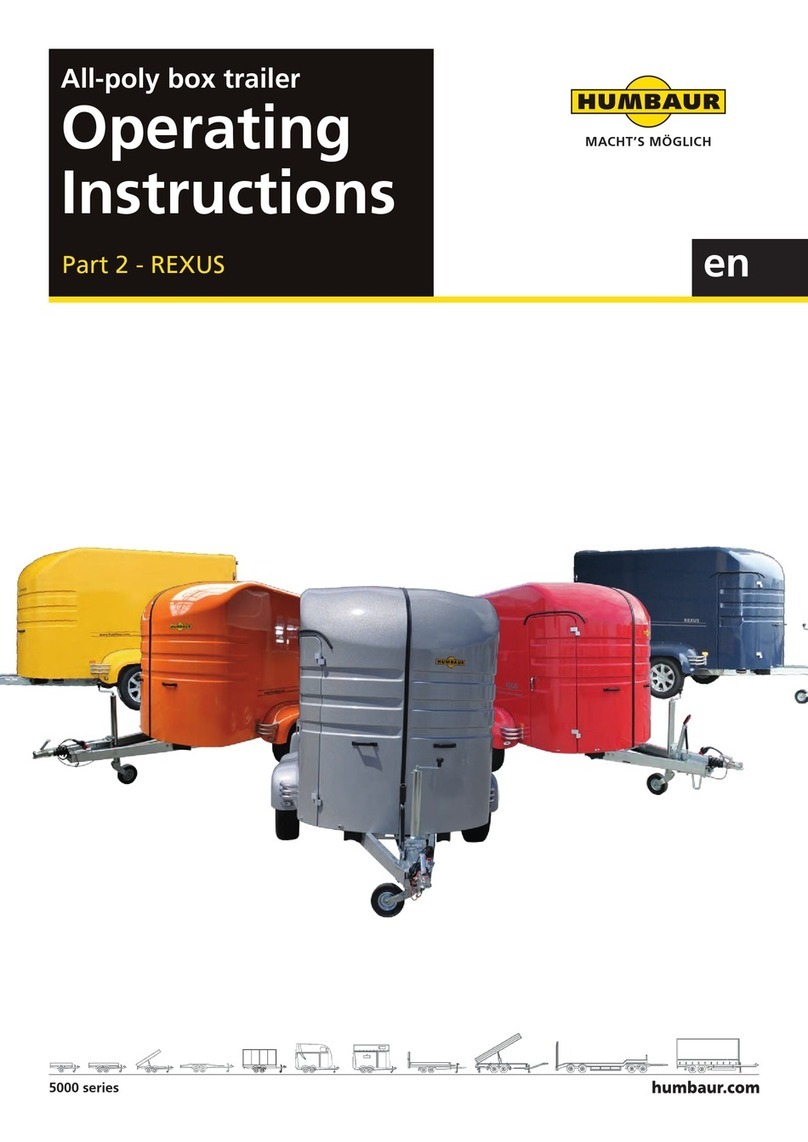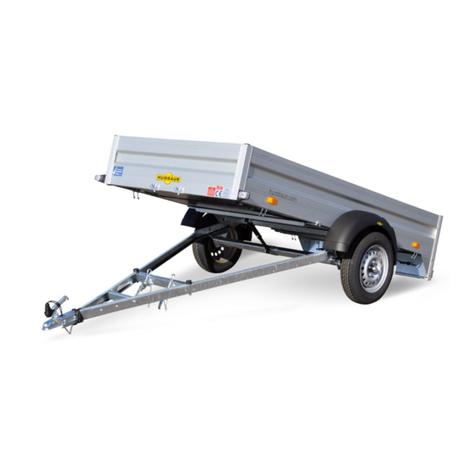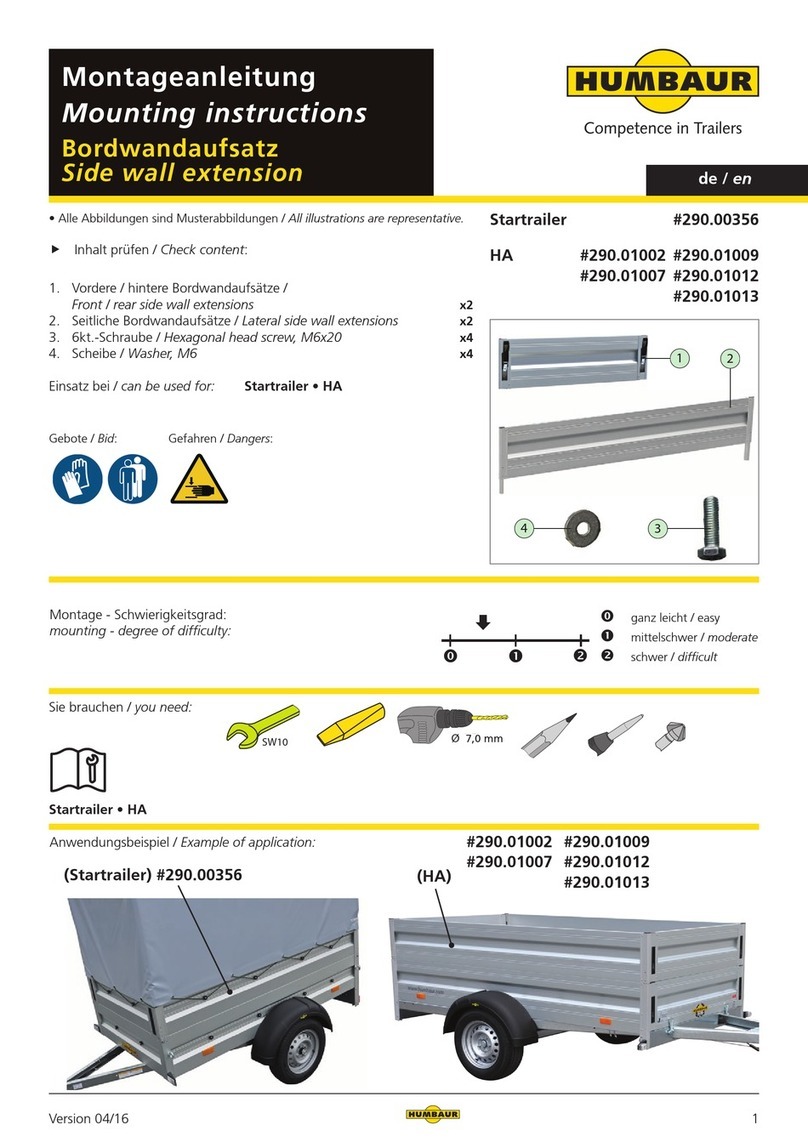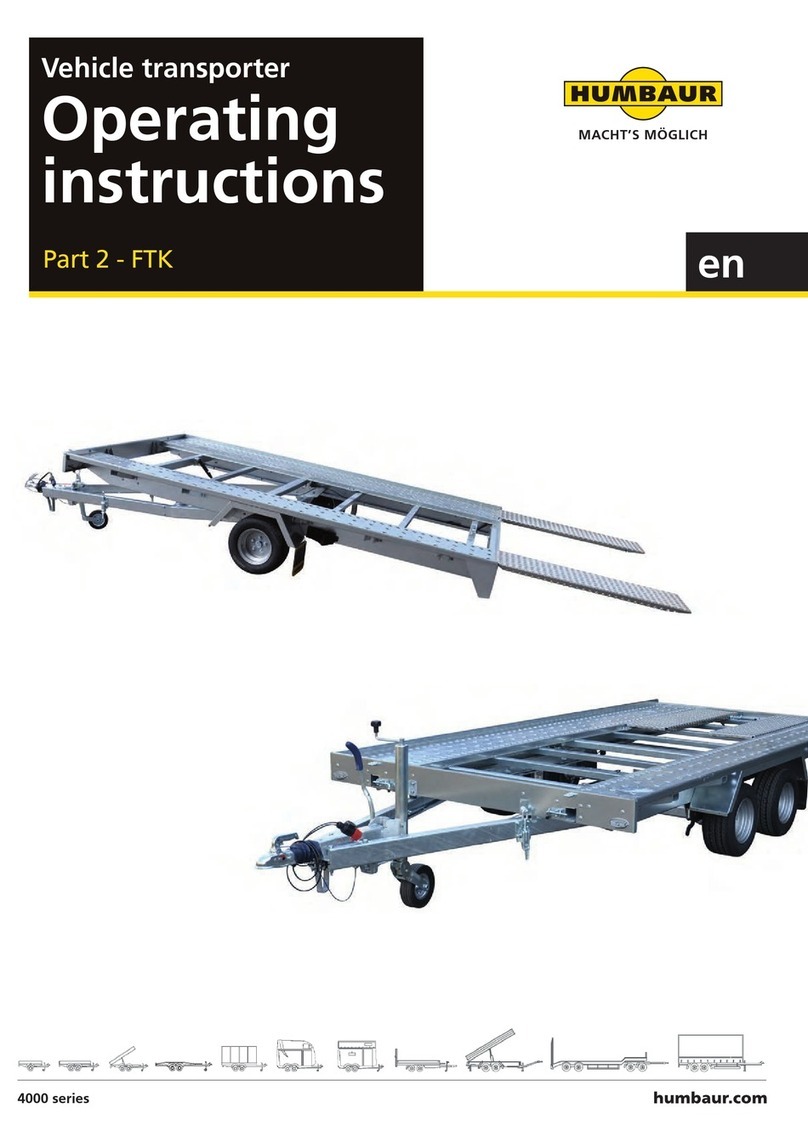
8/56 V 03/2018 Original Operang Instrucon Manual
Worn tyre prole / incorrect tyre pressure!
The tyres can burst when driving along and the trailer will start to
break away. The braking distance increases.
The trailer may start to skid, p over and be uncoupled from the
towing vehicle.
►Regularly check the tyres.
►Check the tyre pressure, prole depth and condion of
the tyres.
Loose wheel nuts / wheel bolts!
The wheel nuts / wheel bolts could come loose.
Trailer could lose a wheel - risk of snaking / an accident!
►Aer the rst 50 km, aer the rst drive with a load, and
every me aer changing the tyres, ghten the wheel
nuts / wheel bolts.
►Check that the wheel nuts / wheel bolts are seated se
curely at regular intervals.
WARNUNG WARNING
Gefahr des Radlösens!
Lose Radmuttern führen zu Unfällen.
Radmuttern nach 50 km
und nach jedem Radwechsel
nachziehen.
Danger of a loss wheel!
Loose wheelnuts result in accidents.
Check wheelnuts for thightness
after the first 50 km and after
each subsequent wheel change.
620.00037_C
Unsecured / poorly secured load!
The load can shi during the trip and could unbalance the trailer
or could be directly thrown o the trailer.
►Tie down the load before driving o.
►Ensure that the load is adequately secured when taking a
break.
►Pay aenon to naonal regulaons on load securing.
Driving without the safety cable / arrester cable at-
tached!
In the event of the trailer becoming detached or if the coupling
fails, the trailer will not be braked / caught - risk of accident!
►Connect the safety cable / arrester cable to the towing
vehicle.
►Pay aenon to the naonal regulaons on this.
Non-compliance with the drawbar load!
Exceeding the max. permissible drawbar load / not reaching the
min. drawbar load can cause accidents - risk of snaking!
►Distribute the load so that no negave drawbar load is
created or that the maximum permissible drawbar load is
complied with.
►Do not exceed the maximum permissible drawbar load
of the towing vehicle and the trailer coupling.
►Observe the informaon on the maximum
permissible drawbar load in your vehicle papers
and the trailer coupling.
►Observe the informaon on the maximum permissible
drawbar load in the COC papers, Secon 19.
VORSICHT CAUTION
Nichteinhaltung der Stützlast
Unfallgefahr / Schlingergefahr!
Verteilen Sie die Ladung so, dass keine
negative Stützlast entsteht bzw. die
max. zul. Stützlast eingehalten wird.
Noncompliance with vertical load
Risk of accident / skidding!
When distributing the cargo, a negative
vertical load mustn’t arise and the max.
perm. vertical load has to be adhered.
620.00404_A
Worn trailer coupling!
A worn trailer coupling leads to poor road handling of the trailer -
risk of snaking!
►Make sure that the coupling is not worn / deformed
before driving o.
►Carry out regular maintenance of the coupling to prevent
wear.
Inadequate / faulty lighng!
It is dicult to see the trailer or it will not be seen in me by
other road users - risk of accident!
►Before seng o, check that the lighng on the trailer is
working and is not covered by the load.
►Remedy any defects to the lighng.
2.4 During loading / unloading
Inadequate lighng!
When loading / unloading, the lighng on the trailer could be
covered up - meaning the trailer is dicult for road users to see
(at dusk /in the dark) - risk of accident!
►Make sure that road trac safety is not impaired when
loading / unloading the trailer.
►If necessary, use addional signalling devices, e.g. signs,
barriers.
WARNUNG WARNING
Unzureichende Beleuchtung
beim Be- und Entladen!
Erhöhte Unfallgefahr.
Sichern Sie den Anhänger mit
zusätzlichen Signaleinrichtungen.
Inadequate lighting during
loading and unloading!
Increased risk of accidents.
Secure the trailer with additional
signalling devices.
620.00038
2.5 When parking
Unsecured trailer!
The trailer can start moving out of control and could injure people
- risk of accident!
►Secure the trailer against rolling away.
►Place the wheel chocks under the wheels.
►Apply the parking brake.
►Park the trailer on ground which is as level as possible
(not on a slope).
►Park the trailer so that it does not pose any further risks.
►Secure the trailer against being used by unauthorised
third pares (an-the device).
Standing / hanging trailer on its end!
The trailer could p up and fall down.
People could be knocked / crushed.
►Secure the trailer against falling over.
►Tie the trailer to a solid wall.








































